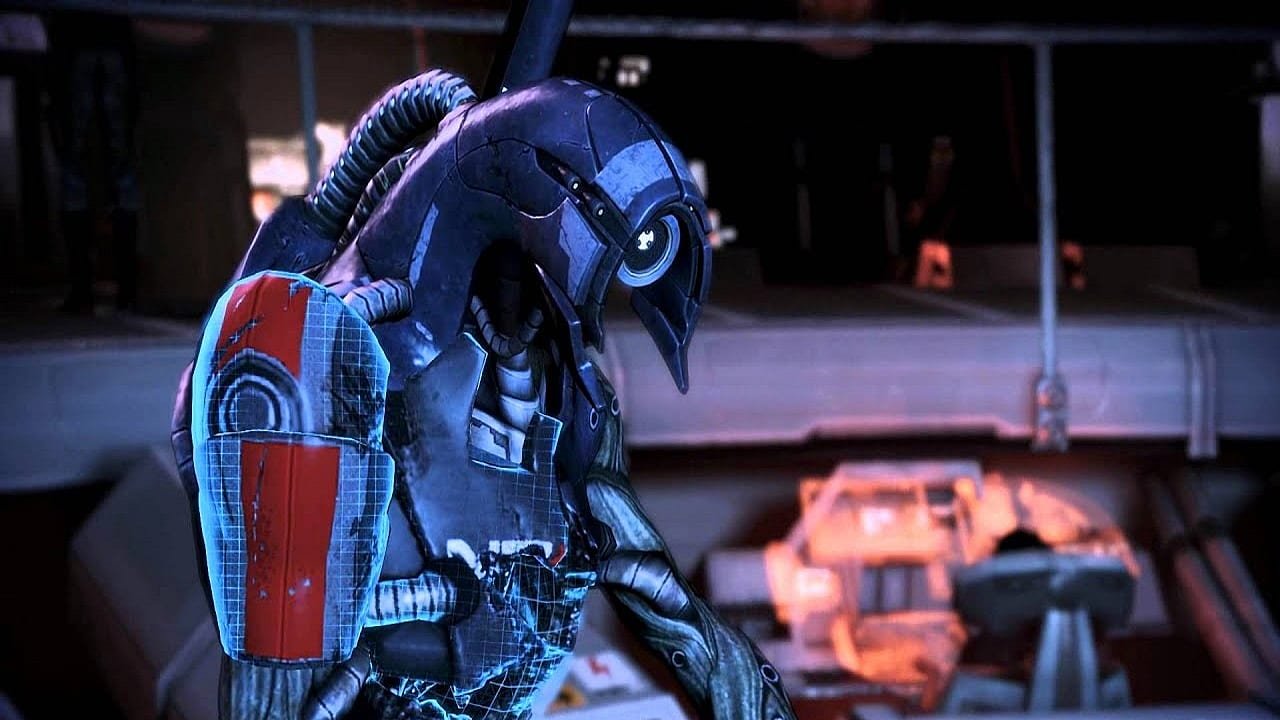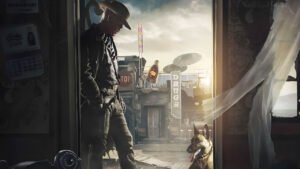In the second and final part of this interview, we continue our talk with Patrick Weekes, Lead Writer at BioWare, and Dave Feltham, Senior Level Designer, about the process of creating downloadable content for their already sizeable games.
On the writing side of things, is there much difference between scripting for DLC and for a “base game?” Are there limitations to be considered such as access to voice actors, or availability of certain staff for set-piece action sequences or designing new environments that impact the way the stories are told?
Patrick Weekes: On the writing side, we knew that we weren’t getting our follower voices back, and that was a limitation. We initially considered having the mission just be Shepard and Liara with no “silent follower”, but we didn’t want to have to limit the combat difficulty for one squad member instead of two.Dave Feltham: Yeah for sure, your henchmen are extensions of your weapons and powers. You can’t remove that without significant gameplay repercussions.
Patrick Weekes: We ended up working around that limitation by giving Shepard and Liara more banter – after all, we knew Liara would be there. It kept the levels from getting too quiet, and fans seemed to react very positively to having Shepard and Liara talking to each other more.
Dave Feltham: It also added some intensity, and humour, to the car chase and the hatch fight on the outside of the Shadow Broker’s ship. ‘It’s a taxi. It has a fare meter.’ is probably one of my favourite lines next to Minsc’s “Butt-kickin’ for goodness!”

In terms of level design, making content for DLC is a lot easier – or more appropriately it’s smoother than making content for the main game. This is because you’re working within known parameters: game systems, art direction, enemies and powers have already been established. The devil you know is better than the devil you don’t.
Patrick Weekes: Each of our content DLCs is essentially a small game, with plots and characters that have to work on their own. On some games, I could see this being a major limitation, but the structure of Mass Effect 2 really made it work well, because the main game, with the Collectors plot surrounded by follower acquisition and loyalty missions, was already a series of small, powerful, standalone character studies.
It’s like the difference between a novel and a collection of short stories. It’s hard to add another chapter of content to a novel without it feeling tacked on, but you can add another short story to a collection, and it still feels like it fits. I think one of the biggest compliments we received was, “This felt like it could have been in the main game.”
How does the voicing availability work for DLC? Obviously, you had the full cast there for the main game, but when it comes to DLC, is this the sort of thing that’s planned for ahead, where you record dialog for DLC during the production process of the game? Or do you reach out to the actors and get them to come back to the studio for additional recording at a later date?
Patrick Weekes: While we have the overarching story planned for the DLC pretty far ahead, there’s no way for us to have it written early enough to get people recorded for DLC while they’re in doing main-game work. If we could get something recorded that early, we’d probably just try to get it into the game itself. In fact, on the Shadow Broker DLC, we did record some temporary dialog for Liara on Illium.
As it turned out, though, the plot changed so that Liara stays on the Shadow Broker ship instead of coming back to Illium, and none of that dialog ended up getting used except for one lead-in line. There’s really no way to plan that far ahead on something as specific as a line of dialog.
It’s even more complex for any dialog that takes place during a combat section. We always end up tuning those lines to give players the right context – warnings about incoming dropships and bombs going off and, you know, things we want the player to notice.
Again on the writing side of things, how do the writing duties get divided up? BioWare is one of the few companies that actually has a team of writers, so is it simply a matter of “character writers” getting re-assigned to their characters from the base game or is there some other process that determines who is plotting out the DLC?
Dave Feltham: Actually before Patrick tackles this, I’d like to point out that that is actually changing; a lot of developers are starting to realize the importance of writers and hiring full-time writers and in some cases full writing teams. While many studios don’t have the amount of writers that BioWare does, we’re starting to see a movement in other developers.
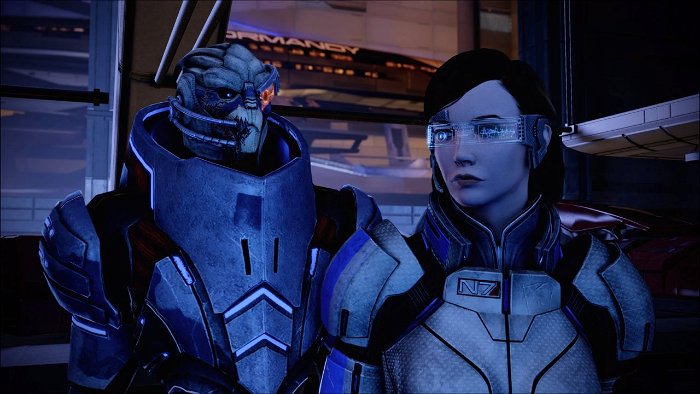
Patrick Weekes: When writing the main game, the writers usually split things up by character, but in a DLC, where we’re dealing with characters who didn’t get a lot of face time in the main game, we generally split things up by mission section. Jay Watamaniuk handled most of the Illium section and the voice-work for Tela Vasir, the asari Spectre.
Sylvia Feketekuty handled the Shadow Broker ship and wrote most of Feron and the Shadow Broker, the two major characters for those levels. I wrote the Liara scenes and banter across the entire DLC to make sure we had a consistent voice, and Mac Walters, our lead writer, made sure that the whole thing came together coherently and to a BioWare standard of quality.
Does the DLC allow for experimentation, and if so, how? In other words, do you get a chance to try things out in DLC that maybe you wanted to toy with in the base game, but couldn’t? Are there any standout examples of where this worked out?
Dave Feltham: Designers always want to try something new. Always. But sometimes the deadlines and resources of working on a full game doesn’t give the breathing room to try new things. DLC gives us that breathing room and allows us to try new things. As Patrick mentioned, in Kasumi, Level Designer Dave Stenton and his team tried a whole James Bond-type heist. In Shadow Broker it was the car chase. Patrick and I knew from the moment we started fleshing out what Shadow Broker would be that we wanted a chase. Initially we thought we’d do a chase in vein of the Zora chase in Blade Runner.
But after talking we realized that fantasy fulfillment for the players of Mass Effect 2 would be to actually fly through Illium, to be able to play that scene from The Fifth Element. And because of my background in car games I knew how relatively simple it would be set it up. Yes it would be a lot of hard work, but we could do it with existing assets. There was a lot of resistance: could art pull it off in the time we had? would the gameplay be fun? would we need new things from programming?
So I took about a week, maybe just over a week, and pulled together a working prototype and that prototype alone sold everybody on the idea and how straightforward the idea would be to implement. It would mean a lot of hard work: Art would have to make some new pieces and textures, Design would have to refine the handling and because animation was focused on the Shadow Broker character, I would have to take on all the animation work found in the level. Luckily I have an animation background so it wasn’t too much of a stretch. It was a lot of hard work but I think in the end it was worth it.
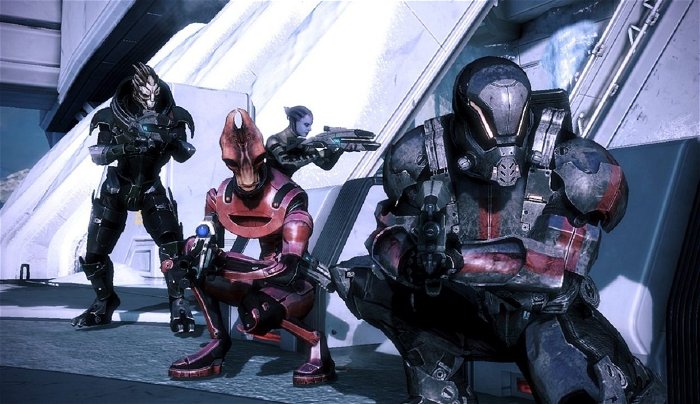
Besides the car chase we were able to do two boss fights in a way we haven’t before: a multi-stage boss fight that had Vanguard powers and of course the melee attacks against the Shadow Broker. A lot of work went into those in design to make them fun and something new.
Patrick Weekes: On the writing end, we used this as a chance to experiment with giving Shepard more of a voice, having Shepard respond automatically instead of waiting for a player to make a choice when that choice didn’t affect the plot. We got a very positive reaction from it, and I wouldn’t be surprised if we saw something like it moving forward.
Dave Feltham: I should also mention that Art got to push the boundaries of visual fidelity and I think that’s really seen in the outside of the Shadow Broker ship. I’m still floored when I see it. And that engine room is just SICK.
Is there ever a sense of fatigue that comes from doing DLC? After all, this is a game that’s been in the works for two or more years in many cases, and it’s not unheard for existing assets to be re-used, such as the extensive revisiting of locations in the Witch Hunt DLC. Do you ever feel like you’d rather be working on the next, full blown game already, or does it feel good to go back to old haunts?
Dave Feltham: That’s a good question. Any job comes with its sense of fatigue, whether it is a full game or DLC: by the end you want it to work properly, you want it to be on the shelves and you want to see what everyone thinks. With regards to DLC everyone here approaches DLC from the perspective of ‘How do we build on what we did before? How do we make it better?
How do we make it different?’ Which is why you see such different things such as the car chase in Shadow Broker, the fight on the Satellite Dish in Overlord or the Heist in Kasumi. Plus we’re always challenging ourselves and we want to outdo what we did last time. Finally we all have a tendency to ask to work on things that are different from what we did before: we’re sadists that way. I worked on the Waking Up level (the tutorial), Mordin Loyalty and Zaeed in Mass Effect 2 and I wanted to make sure that whatever I worked on for Shadow Broker put me in a position to better myself as a designer.
Patrick Weekes: For me, it’s all about what phase of the project we’re in. Every plot we work on goes through an intense planning and iteration process. That’s part of what makes our levels great, but it’s also exhausting, and I think most writers would agree that writing plots is more fun than writing documentation. Any time I get to write something that goes into the game, I’m a happy camper, and working on DLC was a nice change of pace from planning our future main-game content.

When creating DLC, is there greater sense of tension or is it more relaxed? Are the deadlines harder to meet? How does the workflow of DLC compare to the main game?
Dave Feltham: There’s always tension while you’re pitching the idea and iterating on it to make it something that everyone can agree on…
Patrick Weekes: Man, it’s amazing to look at how polished it is now and see how many times we changed the plot in the pitch stage. First our plan was to rescue Liara from Shadow Broker forces. Then we realized that that was too close to how the player rescued her in the first Mass Effect, and it made her seem helpless, when the whole point of the Redemption series and her voice on Illium was that she wasn’t helpless anymore.
We were also going to start on Illium and then go to Omega, to tie into Liara’s adventures on Omega with Feron. Then we realized it sapped the dramatic tension to have you meet Liara in this exciting scene and then fly over to Omega whenever you felt like it, and so eventually the chase got moved from Omega to Illium and became the skycar scene we all know and love, and it’s immediate, not “Hey, let’s go chase after this person when you’re ready.” You end up with something fantastic, but it’s always tense getting there.
Dave Feltham: When you finally get around to creating content it’s a lot more relaxed; scripting is that much easier, the levels come together faster. By the time Shadow Broker was started we were all very familiar with the tools and assets, a lot of the art existed and all the systems were complete and shipped. The deadlines are shorter yes, but we don’t have any of the long planning and decision making that comes with making a full game, or worry about how 40 hours of gameplay will be experienced by the player, or working concurrently with systems that are being developed. We can just concentrate on making a—comparatively—short fun DLC.
Patrick Weekes: Beyond just generally wanting to do justice to Liara and the Shadow Broker arc, the biggest source of tension for me, and for Dave Stenton, the level designer for the opening of the DLC, was figuring out how to get it started in a way that felt natural. How you get the plot started, how you get the Samara and Thane Acquisition plots if Liara is gone, that kind of thing. Liara was integrated deeply into the main Mass Effect 2 story on Illium, which meant we had to be very careful with moving her out into her own DLC so that the main gameplay experience wasn’t disrupted.
Dave Feltham: In the end because of the smaller team, the closer connection you have with this small story, there is, for me at least, a more profound sense of satisfaction when you ship a DLC. When you ship a game, you’re part of a huge family that created something huge, something you’re all very proud of. On DLC it’s more like that old-school garage game feeling. I’m proud of both, but there’s something about the close tangibility of working on DLC that is that much more satisfying.
What’s the fan reaction been like to the DLC?
Dave Feltham: After the release of the game people at work started sending me links to the BioWare social site, to comments on gaming sites, to blog entries about Shadow Broker. And man, were they positive! It was so great to see people enjoying the hard work everyone put in to this because this whole DLC was for the player; we wanted them to extend their relationship with Liara, to see more of the Mass Effect universe. And they were totally digging it! Patrick and I high-fived many times over the first few days of release. Well…maybe fist-bumped because that’s cooler.
Patrick Weekes: Because this DLC was coming out almost eight months after Mass Effect 2’s release, we knew the people playing it were going to be the really die-hard fans, the ones who have the most love and the highest demands. Our mantra in the writing room was to make this module a love letter to our fans, and it’s humbling to see people respond so positively.
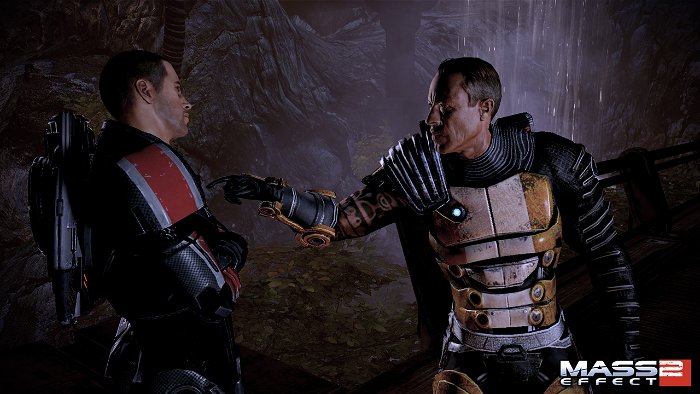
Dave Feltham: It really is. There’s nothing like being sure that you’re part of something that people will love, plunging forward into unknown territory because you know that the amount of work put into it will pay off in player reaction. There’s nothing like going on youtube and watching some guy from New Jersey playing your level dropping f-bombs every other word because everything they’re seeing is new, refreshing and totally not what they were expecting.
In the past, BioWare has released “metrics” of the game data that has been quietly compiled, such as the surprising stat that 80% of the players took the soldier class. Is all this raw research data something that influences the design of future games and DLC, and if so, how?
Patrick Weekes: The writing team doesn’t usually write lines that reflect a specific class choice – we have enough branching and player choice already, and it’s not like in Dragon Age: Origins, where being a mage really separates you from normal human society and requires different dialog. On the other hand, seeing how many people chose to pursue a given romance or which characters were likely to survive the endgame suicide mission gave us some clues as to how we should proceed with future plotlines in the Mass Effect universe.
Dave Feltham: All I can say to that is that metric was shocking to me. I mean Vanguard Charge is where it’s at! Why would anyone take a soldier?
Patrick Weekes: I apologize for Dave’s poor spelling of “Infilitrator Assassination Cloak”, above.
